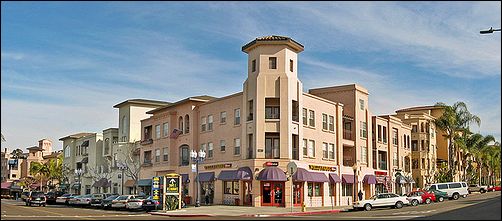by James A. Bacon
One of the more potent criticisms of the Smart Growth movement is that smart growthers implement policies that restrict development, create housing shortages and make housing unaffordable for the poor and working class. The critics present ample evidence that metro regions with the tightest restrictions on development and re-development have higher housing prices overall than regions with fewer restrictions.
But there is more than one way to achieve Smart Growth, at least in theory. One way is is libertarian in inspiration: rolling back the suburban-inspired zoning codes that segregate land uses, cap density restrictions and impose minimum parking requirements on property owners. Undoing the massive government intrusion in local land use would go a long way to reversing the so-called “suburban sprawl” that is the antithesis of Smart Growth without imposing restrictions on new development. A different approach to Smart Growth is more activist: encouraging mixed use development and re-development, seeking more density and curtailing parking in order to push people out of cars.
Suburban zoning codes and regulations are almost universal across America in places developed since World War II, and even in some traditional urban cities. To what extent have activist city governments offset suburban mandates with Smart Growth and environmental mandates? Michael Lewyn and Kristoffer Jackson set to find out. You can read their conclusions in “How Often Do Cities Mandate Smart Growth or Green Building?” in a paper published by the Mercatus Center.
Lewyn and Jackson examined the zoning regulations of 24 medium-sized cities across the United States with a focus on parking, density and “green building.”
Parking. They found that Smart Growth regulations are not nearly as ubiquitous as sprawl-inducing regulations. Fifteen of the 24 cities had restricted parking supply, but only three had restricted the supply citywide for all land uses. The others limited their restrictions to certain parts of the city or to particular land uses.
Density. While restrictions on maximum density are almost universal across the United States, mandates for minimum density are rare, and when they exist, they are largely irrelevant. For example, San Jose, Calif., imposes a minimum density of one house per acre. But the demand for housing is strong and prices are so high that no one is asking to build at lower densities. Indeed, most cities continue to limit density and mixed-use development — the antithesis of the Smart Growth vision.
Green building. Cities have been willing to experiment with “green building” regulations designed to increase energy efficiency. Only four of the 24 cities surveyed compel developers to meet green building standards. Six others give builders incentives to adopt green building standards, while another eight impose the requirements only upon city-owned buildings.
“Government regulation designed to force smarter, more environmentally friendly growth may face a difficult tradeoff,” the authors write. “If regulations are only slightly more restrictive than what an unregulated market might produce, they may not do very much good. But if regulations are significantly more restrictive, they may encourage development to shift to less environmentally sensitive municipalities.”
Writing in the Market Urbanism blog, Emily Washington provides a useful gloss on the Lewyn-Jackson paper.
Lewyn and Jackson’s study shows that rather than embracing the deregulatory tenets of Smart Growth, regulators in some cities have layered Smart Growth rules on top of their traditional zoning rules, creating a complicated web of regulations. … This paper demonstrates that today Smart Growth policies are unusual relative to traditional zoning rules that restrict density. However, Smart Growth is in some cases complicating the policy landscape rather than providing more freedom for developers to respond to consumer demand.
Bacon’s bottom line: The only thing I would add to Lewyn, Jackson and Washington is that it would be useful to study transportation policy. The Smart Growth movement is also enamored with walkability, bicycles, mass transit and complete streets. The pursuit of these policies is not seen as much in city zoning codes as in their capital investment programs. This is the area, it seems to me, where the Smart Growth movement has made its greatest mark.



